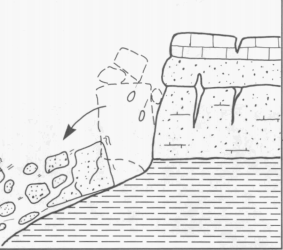Geography
Landslide and Flash Floods
- 16 Jul 2021
- 5 min read
Why in News
Recently, heavy rains caused flash floods and landslides in many parts of Himachal Pradesh.
Key Points
- Landslide:
- About:
- A landslide is defined as the movement of a mass of rock, debris, or earth down a slope.
- They are a type of mass wasting, which denotes any downward movement of soil and rock under the direct influence of gravity.
- The term landslide encompasses five modes of slope movement: falls, topples, slides, spreads, and flows.

- Causes:
- Slope movement occurs when forces acting downward (mainly due to gravity) exceed the strength of the earth materials that compose the slope.
- Landslides are caused due to three major factors: geology, morphology, and human activity.
- Geology refers to characteristics of the material. The earth or rock might be weak or fractured, or different layers may have different strengths and stiffness.
- Morphology refers to the structure of the land. For example, slopes that lose their vegetation to fire or drought are more vulnerable to landslides.
- Vegetation holds soil in place, and without the root systems of trees, bushes, and other plants, the land is more likely to slide away.
- Human activity which includes agriculture and construction increases the risk of a landslide.
- Landslide-Prone Areas:
- The entire Himalayan tract, hills/mountains in sub-Himalayan terrains of North-east India, Western Ghats, the Nilgiris in Tamil Nadu Konkan areas are landslide-prone.
- Mitigation:
- Restriction on the construction and other developmental activities such as roads and dams in the areas prone to landslides.
- Limiting agriculture to valleys and areas with moderate slopes.
- Control on the development of large settlements in the high vulnerability zones.
- Promoting large-scale afforestation programmes and construction of bunds to reduce the flow of water.
- Terrace farming should be encouraged in the northeastern hill states where Jhumming (Slash and Burn/Shifting Cultivation) is still prevalent.
- Step Taken:
- The Geological Survey of India (GSI) has done a national landslide susceptibility mapping for 85% of the entire 4,20,000 square km landslide-prone area in the country. The areas have been divided into different zones according to the propensity of the disaster.
- Improvement in early warning systems, monitoring and susceptibility zoning can reduce the damage caused by landslides.
- The Geological Survey of India (GSI) has done a national landslide susceptibility mapping for 85% of the entire 4,20,000 square km landslide-prone area in the country. The areas have been divided into different zones according to the propensity of the disaster.
- About:
- Flash Floods:
- About:
- These are sudden surges in water levels generally during or following an intense spell of rain.
- These are highly localised events of short duration with a very high peak and usually have less than six hours between the occurrence of the rainfall and peak flood.
- The flood situation worsens in the presence of choked drainage lines or encroachments obstructing the natural flow of water.
- Causes:
- It may be caused by heavy rain associated with a severe thunderstorm, hurricane, tropical storm, or meltwater from ice or snow flowing over ice sheets or snowfields.
- Flash Floods can also occur due to Dam or Levee Breaks, and/or Mudslides (Debris Flow).
- In areas on or near volcanoes, flash floods have also occurred after eruptions, when glaciers have been melted by the intense heat.
- The intensity of the rainfall, the location and distribution of the rainfall, the land use and topography, vegetation types and growth/density, soil type, and soil water- content all determine just how quickly the Flash Flooding may occur, and influence where it may occur.
- Mitigation:
- Instead of valleys, people should live in areas on slopes with firm ground for safety reasons.
- In areas where ground fissures have developed, appropriate steps should be taken to check the infiltration of rainwater and surface water.
- Banning "indiscriminate" and "unscientific" construction works.
- About:




